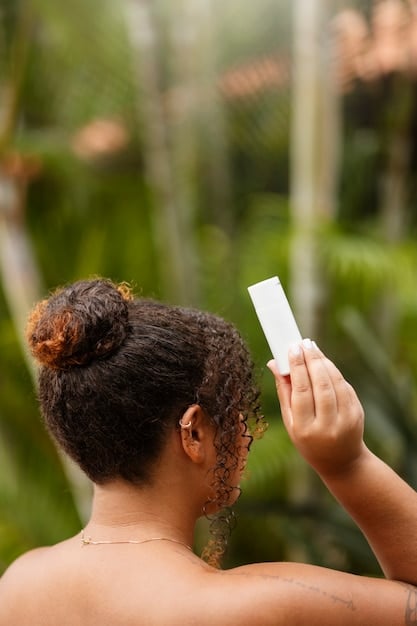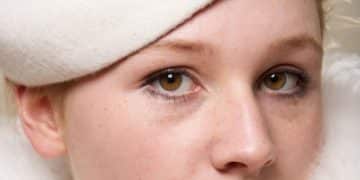Summer Hair Care: Protect Your Locks from Sun Damage with 3 Hydrating Treatments

To safeguard your hair from the damaging effects of summer sun, choosing specific hydrating treatments is paramount, focusing on formulations that deeply nourish, repair, and shield strands, ensuring vibrant, healthy locks throughout the season.
As summer approaches, the allure of sun-drenched days beckons, but it also brings a unique set of challenges for our hair. Optimal Summer Hair Care: Protect Your Locks from Sun Damage with These 3 Hydrating Treatments is more than a luxury; it’s a necessity to maintain hair health and vibrancy. Understanding the impact of environmental aggressors and implementing targeted protective measures can make all the difference.
The Summer Hair Challenge: Understanding Sun Damage
Summer, for all its joys, presents a formidable opponent to the health of our hair. The combination of intense ultraviolet (UV) radiation, chlorine from swimming pools, and salt from ocean water creates a perfect storm for damage. This environmental assault can strip hair of its natural moisture, degrade its protein structure, and fade color, leading to brittle, dull, and frizzy strands. Understanding how these elements specifically affect hair is the first step in formulating an effective counter-strategy.
UV radiation, much like it harms our skin, penetrates the hair cuticle, weakening the protein bonds within the hair shaft. This process, known as photodegradation, makes hair more susceptible to breakage, reduces its elasticity, and can even alter its texture. Chlorine, on the other hand, is a powerful oxidizing agent that can strip away the hair’s protective oils, leaving it dry and porous. For color-treated hair, chlorine can accelerate fading and, in some cases, even impart an unwanted greenish tint.
Similarly, salt water, while seemingly natural, draws moisture out of the hair through osmosis, leading to dehydration and frizz. The rough texture often experienced after a swim in the ocean is a direct result of microscopic salt crystals accumulating on the hair shaft, disrupting the cuticle and making strands feel coarser. These cumulative effects demand a proactive approach to hair care.
The Science Behind Sun’s Impact on Hair
At a microscopic level, hair is comprised primarily of keratin, a fibrous protein. UV radiation breaks down the disulfide bonds that give keratin its strength and structure. This molecular disruption diminishes the hair’s structural integrity, making it more fragile and prone to split ends. The melanin responsible for natural hair color can also be oxidized, leading to lightening or unwanted brassy tones.
- UV-A and UV-B Radiation: Both types contribute to hair damage. UV-A can penetrate deeper, affecting the hair’s cortex and leading to long-term structural changes, while UV-B primarily impacts the cuticle, causing surface damage and color fading.
- Oxidative Stress: Sun exposure generates free radicals in the hair, which attack healthy cells and proteins, accelerating signs of damage and aging in hair fibers.
- Protein Degradation: The amino acids that make up hair proteins are highly susceptible to UV-induced degradation, resulting in a weakening of the hair shaft and increased porosity.
Recognizing these specific mechanisms of damage underscores the importance of shielding hair from sunlight, much like we protect our skin. Simply covering hair with a hat offers a physical barrier, but for comprehensive protection, especially for those who spend significant time outdoors, deep hydration and strengthening treatments become crucial.
The cumulative effects of summer’s environmental aggressors extend beyond cosmetic concerns. Severely damaged hair can become difficult to manage, tangle easily, and lose its natural luster. It can also exacerbate underlying scalp conditions or make hair more vulnerable to chemical treatments like coloring or perming. Therefore, summer hair care is not just about aesthetics; it’s about preserving the fundamental health and resilience of our hair from root to tip.
Treatment 1: Deep Conditioning Masks – Your Hydration Hero
When it comes to rehydrating and protecting sun-damaged hair, a Deep Conditioning Mask stands out as an indispensable tool. Unlike daily conditioners that primarily work on the hair’s surface, deep conditioning masks are formulated to penetrate deeper into the hair shaft, delivering a concentrated dose of nourishing ingredients. Their richer consistency and longer application time allow for more intensive repair and moisture infusion, addressing the profound dryness and damage caused by summer elements.
The effectiveness of a deep conditioning mask lies in its powerful blend of humectants, emollients, and proteins. Humectants, such as hyaluronic acid or glycerin, draw moisture from the air and bind it to the hair, enhancing hydration. Emollients like shea butter, argan oil, or coconut oil, coat the hair shaft, smoothing the cuticle and locking in moisture, thereby reducing frizz and improving manageability. Proteins, often hydrolyzed silk, keratin, or wheat protein, help to rebuild and strengthen the hair’s internal structure, repairing damaged bonds and preventing further breakage.
Selecting the Right Deep Conditioning Mask
Choosing the appropriate deep conditioning mask depends on your hair type and specific concerns. For severely dry and brittle hair, look for masks rich in natural oils and butters that provide intense lipid replenishment. If your hair is color-treated, opt for formulations specifically designed to protect color vibrancy while providing hydration. Protein-rich masks are beneficial for weak, breakage-prone hair, but should be used in moderation to avoid protein overload, which can ironically lead to stiffness.
- For Dry, Damaged Hair: Seek out masks with ingredients like avocado oil, jojoba oil, or hyaluronic acid, known for their superior moisturizing properties.
- For Fine Hair: Choose lighter formulas that won’t weigh down strands, perhaps with aloe vera or lightweight silicones for smoothness without heavy residue.
- For Color-Treated Hair: Prioritize masks with UV filters and antioxidants to prevent color fading and dullness, alongside hydrating ingredients.
The application method is equally important for maximizing efficacy. After shampooing, gently squeeze excess water from your hair—masks are best applied to damp, not soaking wet, hair. Distribute the mask evenly from mid-lengths to ends, focusing on areas most susceptible to damage. For deeper penetration, cover your hair with a shower cap and apply gentle heat, either with a warm towel or by briefly using a hairdryer on a low setting. This opens the hair cuticle, allowing the beneficial ingredients to absorb more effectively. Leave on for the recommended time, typically 5-20 minutes, then rinse thoroughly with cool water to seal the cuticle and enhance shine.
Incorporating a deep conditioning mask into your weekly summer hair care routine, or even twice a week for very damaged hair, can dramatically improve the hair’s texture, strength, and overall appearance. It acts as a protective barrier, reducing the impact of subsequent sun exposure and environmental stressors, fundamentally transforming dry, damaged strands into soft, resilient, and luminous locks.
Treatment 2: Leave-In Conditioners with UV Protection – Your Daily Shield
While deep conditioning masks provide intensive weekly repair, a Leave-In Conditioner with UV Protection serves as your hair’s daily shield against sun damage. These multi-tasking products are designed to be applied after washing and before styling, providing continuous hydration, detangling benefits, and, crucially, a protective barrier against harmful ultraviolet rays. Their lightweight formulations ensure they don’t weigh hair down, making them suitable for everyday use, especially during the peak summer months.
The primary advantage of a leave-in conditioner with UV protection is its ability to offer ongoing defense throughout the day. Unlike rinse-out products, leave-ins remain on the hair, forming a protective layer that mitigates the damaging effects of sunlight, pollution, and even heat styling. The UV filters in these products work similarly to sunscreen for skin, absorbing or reflecting UV radiation before it can harm the hair’s protein structure and color.
Key Ingredients for Effective Protection
Look for leave-in conditioners that combine UV filters with nourishing and strengthening agents. Ingredients such as octyl methoxycinnamate or benzophenone-3 (oxybenzone) are common chemical UV filters, while zinc oxide or titanium dioxide offer mineral protection. Beyond UV defense, these products should contain hydrating ingredients like panthenol (Vitamin B5), amino acids, and lightweight oils (e.g., argan, jojoba), which keep hair soft, manageable, and frizz-free.
- UV Filters: Essential for blocking harmful UV-A and UV-B rays, preserving hair color and structural integrity.
- Humectants and Emollients: To maintain moisture balance and provide a smooth, flexible cuticle, preventing dryness and brittleness.
- Antioxidants: Ingredients like Vitamin E or green tea extract help neutralize free radicals generated by sun exposure, minimizing oxidative stress.
Application is simple and can be integrated seamlessly into your morning routine. After towel-drying your hair, spray or smooth a small amount of the leave-in conditioner evenly through your damp strands, concentrating on the ends that are often most prone to damage. Use a wide-tooth comb to distribute the product and detangle gently. Do not rinse. You can then proceed with your usual styling routine. For extended outdoor exposure, such as a day at the beach or a long hike, consider reapplying the product periodically, especially after swimming, to ensure continuous protection.

Beyond UV protection, these leave-ins often offer additional benefits. Many contain detangling agents, making hair easier to comb through and reducing breakage. They can also help to control frizz, add shine, and provide a light hold, acting as a primer for styling. For those who frequently swim, some formulations provide a barrier against chlorine and salt, further safeguarding hair during summer activities. Incorporating this daily shield is a proactive and effective way to ensure your hair remains healthy, vibrant, and protected throughout the sunniest months.
Treatment 3: Hair Oils and Serums – The Finishing Touch & Repair Elixir
Rounding out the trio of essential summer hair treatments are Hair Oils and Serums. These concentrated formulations serve a dual purpose: they act as a potent repair elixir for existing damage and provide a crucial finishing touch that seals the hair’s cuticle, locks in moisture, and adds a protective sheen. While deep conditioners and leave-ins work on hydration and daily defense, oils and serums offer concentrated nourishment and an immediate cosmetic improvement, leaving hair feeling soft, looking glossy, and further shielded from environmental stressors.
Hair oils, typically derived from natural sources like argan, coconut, or jojoba, are rich in fatty acids and vitamins that penetrate the hair shaft to replenish lost lipids and strengthen its structure. They are particularly effective at combating dryness and frizz, which are common complaints during summer. Serums, often silicone-based, form a thin, protective layer around the hair strands, sealing the cuticle, enhancing shine, and providing a barrier against humidity and heat. Many modern serums also incorporate natural oils and active ingredients for a more comprehensive treatment.
Choosing and Applying Oils & Serums
The choice between an oil and a serum, or a combination, depends on your hair type and desired outcome. For very dry, thick, or coarse hair, heavier oils like argan or coconut oil can provide deep nourishment and taming. For finer hair, lighter oils such as camellia or grapeseed, or lightweight serums, are preferable to avoid greasiness. Look for formulations that explicitly state “non-greasy” or “fast-absorbing.”
- Natural Oils (e.g., Argan, Coconut, Jojoba): Best for deep nourishment, frizz control, and improving hair elasticity. Apply to ends or as a pre-shampoo treatment for intense hydration.
- Silicone-Based Serums: Excellent for immediate shine, smoothing the cuticle, and providing a barrier against humidity and heat. Often contain very light oils for added benefits.
- “Dry” Oils: Formulated to absorb quickly without leaving an oily residue, ideal for all hair types needing a weightless finish.
Application is key to maximizing benefits without oversaturating the hair. For most hair types, a few drops are sufficient. Warm the oil or serum between your palms, then gently distribute it from the mid-lengths down to the ends of slightly damp or dry hair. Focus on the most damaged or frizzy areas. For a pre-shampoo treatment, apply a generous amount to dry hair, leave for at least 30 minutes (or overnight), then shampoo and condition as usual. This can be particularly beneficial for severely dry hair to prevent moisture loss during washing.
Beyond their reparative qualities, hair oils and serums are excellent for creating a polished look. They can tame flyaways, enhance shine, make hair feel incredibly soft, and protect against mechanical damage from styling. Some formulations also offer mild UV protection, although this should not replace a dedicated leave-in with robust UV filters for prolonged sun exposure. By incorporating an oil or serum as the final step in your summer hair care routine, you provide your hair with a concentrated dose of TLC and a beautiful, healthy finish that stands up to the summer elements.
Beyond Treatments: Lifestyle & Practical Summer Hair Tips
While targeted treatments are crucial, comprehensive summer hair care extends to lifestyle adjustments and practical habits. Protecting your strands from environmental stressors requires a multi-faceted approach that complements the hydrating and protective products you use. Integrating these practices into your daily routine significantly amplifies the effectiveness of your hair care regimen, ensuring your locks remain vibrant and healthy throughout the season.
Strategic Protection and Habits
One of the simplest yet most effective ways to prevent sun damage is physical protection. Hats, scarves, or even parasols can provide a direct barrier against UV rays, reducing the intensity of exposure on your hair and scalp. When swimming, wetting your hair with fresh water before entering a pool or the ocean helps to saturate the strands, making them less porous and less likely to absorb chlorine or salt. Applying a leave-in conditioner before swimming further enhances this protective barrier.
- Wear a Hat or Scarf: A stylish way to shield your hair and scalp from direct sun exposure, minimizing UV damage and color fading.
- Rinse Before and After Swimming: Saturate your hair with clean water to reduce absorption of chlorine or salt. Follow with a thorough rinse and gentle shampoo after swimming.
- Gentle Detangling: Always use a wide-tooth comb when detangling wet hair, which is more fragile. Start from the ends and work your way up to minimize breakage.
Proper cleansing and conditioning are also paramount. During summer, hair can accumulate more product buildup, sweat, and environmental impurities. Use a gentle, sulfate-free shampoo to cleanse without stripping natural oils, and follow with a moisturizing conditioner. Avoid excessively hot water, which can further dehydrate hair, opting for lukewarm rinses. Regular trims are also essential to remove split ends and keep hair looking fresh and healthy, especially after sun exposure.
Diet and hydration play an often-underestimated role in hair health. A balanced diet rich in vitamins, minerals, and healthy fats supports strong hair growth from within. Ensuring adequate water intake helps to keep the entire body, including hair and scalp, hydrated. Antioxidant-rich foods like berries, leafy greens, and nuts can help combat oxidative stress caused by sun exposure, contributing to overall hair vitality.

Lastly, be mindful of heat styling. Excessive heat from blow dryers, straighteners, and curling irons can compound sun damage, leading to drier, more brittle hair. During summer, embrace natural air-drying whenever possible or opt for heat-free styling methods. If heat styling is unavoidable, always use a heat protectant spray and select the lowest effective temperature setting. By combining these practical tips with your chosen hydrating treatments, you create a holistic approach to summer hair care that ensures your locks remain resilient, radiant, and beautiful, whatever the season brings.
Common Summer Hair Care Mistakes to Avoid
Even with the best intentions, certain practices can inadvertently exacerbate hair damage during the summer. Recognizing and avoiding these common mistakes is as critical as implementing protective treatments. A mindful approach to your summer hair routine can prevent unnecessary stress on your strands and ensure that your efforts in hydration and protection yield optimal results, maintaining the health and beauty of your hair throughout the sunny months.
Over-Washing and Harsh Cleansers
One frequent mistake is over-washing hair in an attempt to combat sweat and oil. While regular cleansing is important, excessive shampooing can strip the hair and scalp of their natural protective oils, leading to dryness and increased oil production as the scalp tries to compensate. Using harsh shampoos containing sulfates can further aggravate this issue, leaving hair brittle and dull. Instead, opt for gentle, sulfate-free formulas and consider co-washing (conditioner-only washing) on alternate days if your hair doesn’t feel excessively oily.
The temptation to skip conditioner in hot, humid weather is another pitfall. Some believe it will make hair feel lighter, but this often leads to dehydrated strands prone to frizz and tangles. Conditioners are vital for sealing the cuticle, providing moisture, and improving manageability. Always follow shampooing with a suitable conditioner, focusing on the mid-lengths and ends.
Ignoring Scalp Health
The scalp is often overlooked in summer hair care, yet it’s just as susceptible to sun damage, sweat, and product buildup as the hair itself. A neglected scalp can lead to dryness, irritation, flakiness, or even sunburn, all of which can impede healthy hair growth. Using heavy, pore-clogging products on the scalp can also lead to issues.
Protecting the scalp with hats or UV-protective sprays is essential. Regular, gentle scalp massages can stimulate blood flow and help distribute natural oils. Consider incorporating a gentle scalp exfoliant once a week to remove buildup and promote a healthy environment for hair follicles. Remember, healthy hair starts with a healthy scalp.
Excessive Heat Styling
Compounding the damage from sun and environmental elements with excessive heat styling is a recipe for disaster. Using high-heat tools like flat irons, curling wands, and blow dryers without proper heat protection or at overly high temperatures can further dry out, weaken, and break hair strands. The summer heat already puts hair under stress; adding more without caution is detrimental.
Embrace natural air-drying whenever possible. If you must use heat tools, always apply a good heat protectant spray beforehand and use the lowest effective temperature setting. Explore heat-free styling options that allow your hair to dry naturally while still achieving desired styles. This reduction in heat exposure gives your hair a much-needed break and helps it recover from summer’s rigors.
Avoiding these common summer hair care missteps, alongside implementing protective treatments, creates a holistic strategy for maintaining vibrant, strong, and beautiful hair throughout the entire season. A little foresight and adjustment to routine can save your hair from significant damage.
Tailoring Treatments for Different Hair Types in Summer
While the principles of summer hair care remain universal – hydration, protection, and repair – the specific application and choice of treatments should be tailored to individual hair types. What works wonders for thick, coarse hair might weigh down fine strands, and color-treated hair has unique needs compared to natural, virgin hair. Understanding these nuances ensures that your summer hair care routine is not only effective but also optimized for your hair’s unique characteristics, maximizing its health and beauty.
Considerations for Fine Hair
Fine hair, while beautiful, is often more susceptible to damage from environmental stressors and can easily become weighed down by heavy products. The key to summer care for fine hair is selecting lightweight formulations that provide ample hydration and protection without sacrificing volume. Look for leave-in sprays instead of creams, and opt for deep conditioning masks that are specifically designed for fine hair, often labeled as “lightweight” or “volumizing.”
- Lightweight Hydration: Choose sprays and serums with ingredients like aloe vera or rice water that hydrate without heavy oils.
- Protective Styling: Utilize updos or braids to shield delicate strands from direct sun exposure, reducing overall surface area exposed to UV.
- Gentle Cleansing: Use sulfate-free shampoos that cleanse effectively but gently, preventing over-stripping which can make fine hair feel even drier.
When applying oils or serums, use only minimal amounts, focusing purely on the ends, and avoid the roots to prevent greasiness. Less is often more with fine hair to maintain its natural body and bounce.
Considerations for Thick or Coarse Hair
Thick or coarse hair often yearns for moisture and can absorb richer, more potent treatments without becoming oily. This hair type benefits immensely from the heavier deep conditioning masks and richer hair oils that might overwhelm finer textures. These formulations help to tame frizz, enhance softness, and provide deep nourishment to often dry, robust strands.
For thick hair, generous applications of leave-in conditioners with UV protection are beneficial, ensuring even coverage across all strands. Heavier oils like coconut or shea butter can be used more liberally, not just on the ends but throughout the mid-lengths, acting as a powerful humectant and emollient. Pre-shampoo oil treatments are exceptionally effective for this hair type, helping to soften and prepare the hair for washing.
Considerations for Color-Treated Hair
Color-treated hair faces a double threat in summer: sun exposure can cause fading, and pool chemicals like chlorine can alter color tones. Therefore, protecting color vibrancy is paramount. Look for products specifically formulated for color-treated hair, which often contain UV filters, antioxidants, and ingredients designed to seal the cuticle and lock in pigment.
Incorporating leave-in conditioners with strong UV protection is non-negotiable. Deep conditioning masks should focus on repairing damage while also preserving color. Rinsing hair thoroughly after swimming and using a swimming cap can also significantly reduce color degradation. Some specialized products are even designed to neutralize chlorine residues, preventing unwanted green or brassy tones.
By adjusting the depth of hydration, the weight of product, and the specific protective mechanisms to align with your unique hair type, you unlock the full potential of your summer hair care routine. These tailored approaches ensure that every strand receives the precise care it needs to thrive, remaining resilient and radiant amidst the sun and fun of the warmer months.
Long-Term Hair Health: Beyond Summer
While the focus on summer hair care is primarily about immediate protection and repair from seasonal aggressors, the principles you establish during these months lay the groundwork for long-term hair health. The habits formed and the consistency applied to your routine can have lasting benefits, extending far beyond the summer season. Thinking about hair care as a continuous journey, rather than a seasonal sprint, ensures enduring vitality and resilience for your locks.
Establishing Sustainable Routines
The intensity of summer often forces us to confront hair damage head-on, leading us to adopt more rigorous care routines. Carrying over elements of these routines into the fall and winter can prevent accumulated damage and maintain hair’s optimal condition. For instance, continuing with a weekly deep conditioning mask, perhaps reducing the frequency to bi-weekly, helps to continually replenish moisture and repair minor damage. The disciplined use of leave-in conditioners, even when UV exposure is less intense, can provide ongoing environmental protection and detangling benefits.
Integrating hair oils and serums as regular styling aids, rather than just post-summer rescue remedies, can keep the hair cuticle smoothed, reduce frizz, and impart a healthy shine year-round. These products also offer a layer of protection against mechanical damage from styling and the drying effects of indoor heating during colder months.
The practice of gentle handling, always using a wide-tooth comb, and being mindful of heat styling should become ingrained habits. These simple adjustments minimize breakage and preserve the structural integrity of your hair, leading to less fragility and more robust growth over time. Additionally, regular trims, even if just dusting the ends, remain crucial for removing split ends and maintaining the hair’s shape and health.
Nutritional Support and Scalp Care Continuity
The connection between internal health and hair vitality is profound. Maintaining a balanced diet rich in essential nutrients, vitamins, and minerals supports consistent hair growth and strength. The habit of hydrating from within, by drinking plenty of water, benefits not only your body but also contributes directly to the hydration and elasticity of your hair and scalp. These nutritional foundations are not unique to summer; they are fundamental for year-round hair health.
Scalp care is another area where year-round attention pays dividends. Protecting your scalp, ensuring it remains clean and balanced, and addressing any flakiness or irritation promptly, creates an optimal environment for healthy hair follicles. A healthy scalp is the bedrock of healthy hair, regardless of the season. Continuing to use gentle shampoos and considering occasional scalp treatments can prevent issues from developing.
Ultimately, the lessons learned and the successful strategies employed during your summer hair care journey can serve as a blueprint for a comprehensive, effective, and sustainable hair care philosophy. By prioritizing hydration, protection, and gentle treatment year-round, you unlock the secret to consistently vibrant, resilient, and beautiful hair that withstands the tests of all seasons.
| Key Point | Brief Description |
|---|---|
| 💧 Deep Hydration Power | Intensive masks penetrate deep to replenish moisture, crucial for sun-stressed hair. |
| 🛡️ Daily UV Shield | Leave-in conditioners with UV filters offer continuous protection against sun damage. |
| ✨ Finishing & Repair Elixir | Hair oils and serums seal cuticle, add shine, and provide concentrated nourishment. |
| 🌿 Holistic Approach | Combines treatments with practical tips like hats and rinsing before swimming for complete care. |
Frequently Asked Questions About Summer Hair Care
▼
Summer brings unique challenges like intense UV radiation, chlorine, and salt water, which are particularly harsh on hair. These elements can strip moisture, degrade keratin, and fade color, necessitating a more intensive and protective regimen compared to other seasons.
▼
While some damage, especially to the hair’s protein structure, is irreversible, specific hydrating and strengthening treatments can significantly improve the appearance and feel of sun-damaged hair. Regular use of masks, leave-ins, and oils helps repair cuticles, improve elasticity, and prevent further deterioration.
▼
For most hair types, a deep conditioning mask once a week is sufficient. If your hair is severely dry, damaged, or frequently exposed to intense sun, chlorine, or salt, you might benefit from using it twice a week to maintain optimal hydration and repair.
▼
Yes, hats provide excellent physical protection against UV rays, shielding both your hair and scalp. They are a simple and effective way to reduce direct sun exposure, thereby preventing photodegradation and color fading, particularly during prolonged outdoor activities.
▼
For color-treated hair, prioritize leave-in conditioners with strong UV filters. Always wet your hair with fresh water before swimming to minimize chlorine absorption, and consider wearing a swim cap. Look for products specifically designed to protect color while providing intense hydration.
Conclusion
Embracing summer fully means preparing our hair for its unique challenges. By integrating targeted hydrating treatments—deep conditioning masks, UV-protective leave-in conditioners, and nourishing hair oils/serums—into your routine, you can proactively defend against sun, chlorine, and salt damage. This three-pronged approach not only restores moisture and repairs existing damage but also builds robust resilience against future environmental aggressors. Coupled with mindful lifestyle habits like physical protection and gentle care, your hair will emerge from summer as vibrant, healthy, and luminous as the season itself. Prioritizing these foundational steps ensures lasting hair health, ready to shine in every season to come.





